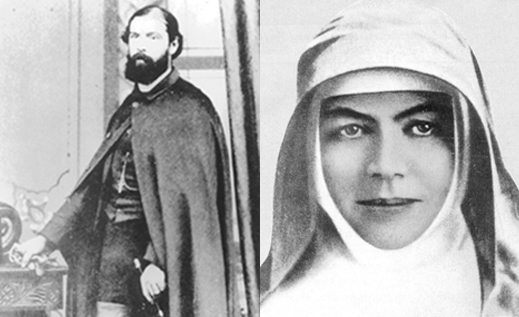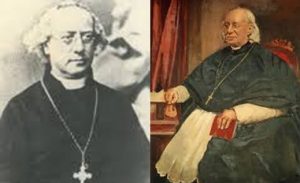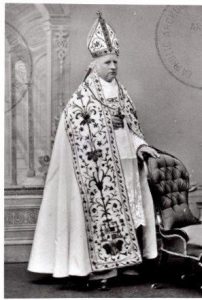
In the year 1866 Father Julian Woods, aided by Mary MacKillop, founded the Sisters of Saint Joseph in Penola, South Australia, for the Catholic Education of children from poor families. [1] But why did this busy priest working in one of the largest mission areas in the colony take this step?
Firstly, South Australia was a free colony where settlers enjoyed religious and political freedom and where there was no government aid for religion. Instead, according to the so-called Voluntary System, members of each religious denomination had to build their places of worship, support their pastors and educate their children in their particular faith. Then, in 1851 the local Legislative Council had abolished all state aid to religion and established a state-controlled system of non-sectarian secular education. [2]
Secondly, in Australia, where Catholics were in a minority, the bishops were afraid that children attending government schools could be lost to the church because they had gained the impression that one religion was as good as another. Consequently, the bishops pressured the clergy to provide separate schools for the catholic children.
Archbishop Polding of Sydney addressed this issue in his Lenten Pastoral of 1859 when he wrote:

At about the same time, Father Patrick Geoghegan of Melbourne became second Bishop of Adelaide. Coming as he did from a colony where gold was being mined in significant quantities, where there were many fine buildings and where its sizeable Catholic population enjoyed the benefits of a well-established, government-supported Catholic school system, he was shocked at the poverty of his congregation, the smallness of their churches and the lack of catholic schools in the colony.
He was horrified when he learnt of the voluntary system and the Secular Education Act of 1851 and decided to take steps to remedy this situation for, as he saw it, the catholic children of South Australia were in danger of losing their faith. Therefore, he wrote a pastoral letter decrying the existing state system as being “a gigantic machinery for propagating Protestantism, and for disaffecting or proselytising the catholic children unhappily coming within its influence from the religion of their parents.” Then, after having copied large sections of Polding’s letter, he told his people that they must in conscience denounce the government schools:
Secondly—Because in [their] poverty and sad want of schools of [their] own, they [were] bribes and temptations held out to [their] children.
Thirdly—Because Catholics [were being] taxed to pay an odious tithe for the suport of the system.
He concluded:

When Julian Woods of Penola received this letter he tried, albeit unsuccessfully, to get properly trained teachers for his area. Then he recalled the memory of the Sisters of St Joseph whom he had met in France and decided that he needed Sisters like them to manage his schools. Eventually, it became clear to him that the only real solution for his problem was for him to found a new religious order there in Penola.
While he was praying and deliberating over his problem, young Mary MacKillop arrived in the district to work as a governess for her uncle’s children. For some years she had felt called to be a religious, but, at the time, was committed to the support of her family. She confided in Fr Woods and, as soon as she could leave the family, she agreed to become one of the first Sisters of St Joseph. [5]
Thus, it is clear that Father Woods founded the Congregation in response to his bishop’s command. In fact, while Bishop Geoghegan laid the groundwork for the foundation, it was his successor, Bishop Lawrence Sheil, who confirmed the idea when he appointed Woods as Director of Catholic Education for South Australia and subsequently approved the Sisters of Saint Joseph as a diocesan congregation in 1868.
Sr Marie Foale
Footnotes:
[1] End of Institute as expressed in the Sisters’ first Rule of Life, as written by Julian. He entitled it: Rules of the Institute of St Joseph for the Catholic Education of Poor Children. According to his Memoirs, he wrote this in May 1867. Bishop Sheil approved it in December 1868 & he had it printed by a local printer.
[2] South Australian Statutes, no. 20 of 1851
[3] Patrick & Deirdre O’Farrell, Documents in Australian Catholic History, Volume 1: 1788-1884, Chapman, London, 1969, “Pastoral Letter of John Bede Polding on the subject of Public Education, 1859” p. 209.
[4] Geoghegan, Pastoral Letter of Patrick Bonaventure, by Divine Grace and Favour of the Apostolic See, Bishop of Adelaide, to the Clergy and Laity of the Diocese, on the Education of Catholic Children, Adelaide, 1860
[5] Mary wrote to Bishop Sheil, 10 September 1871, “The way in which he described their wants so completely agreed with all my previous desires, that when he asked me whether (provided he got the Bishop’s consent to commence an Institute to meet these wants) I would remain and become one of his first children in the flock, I joyfully consented.”
